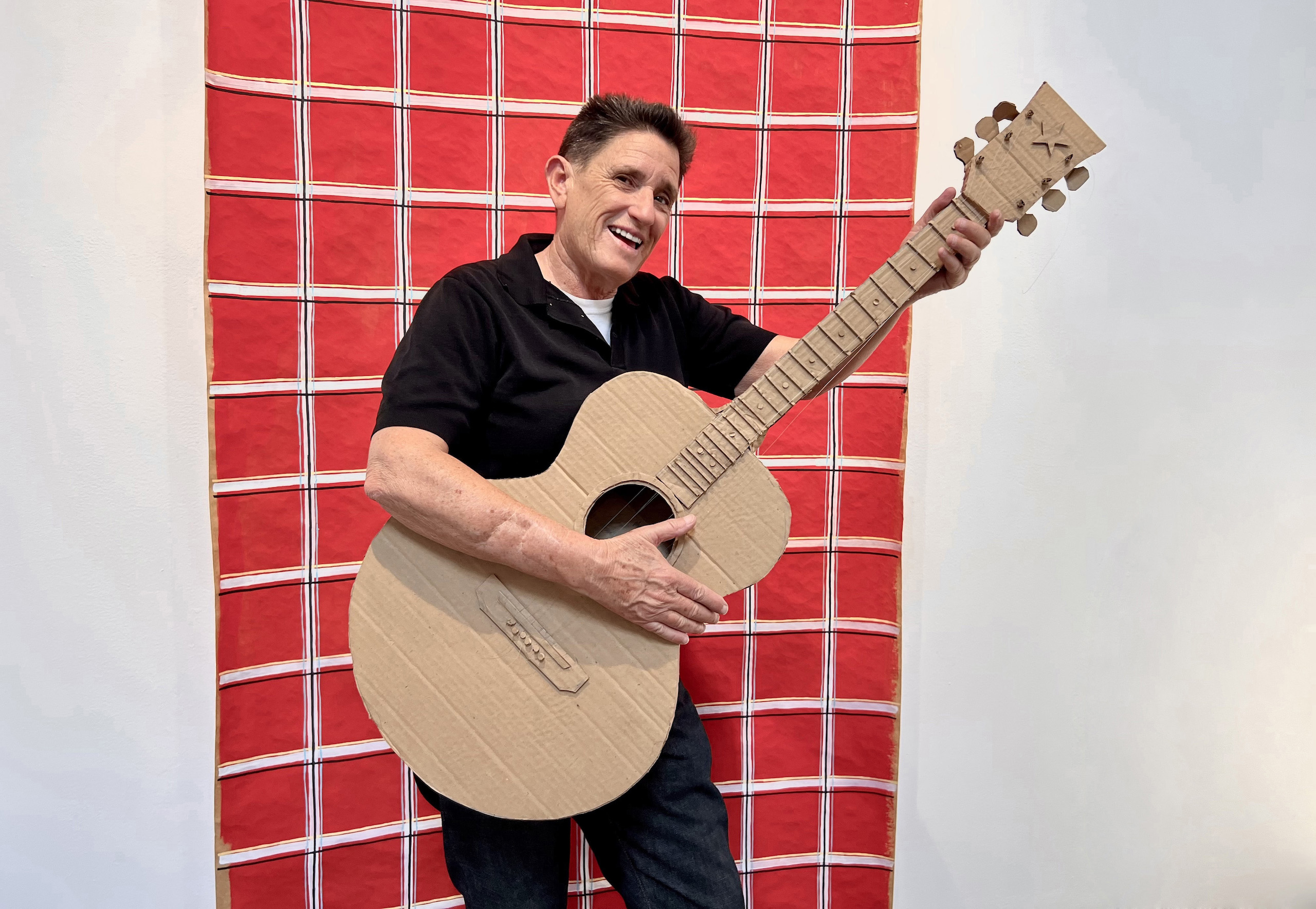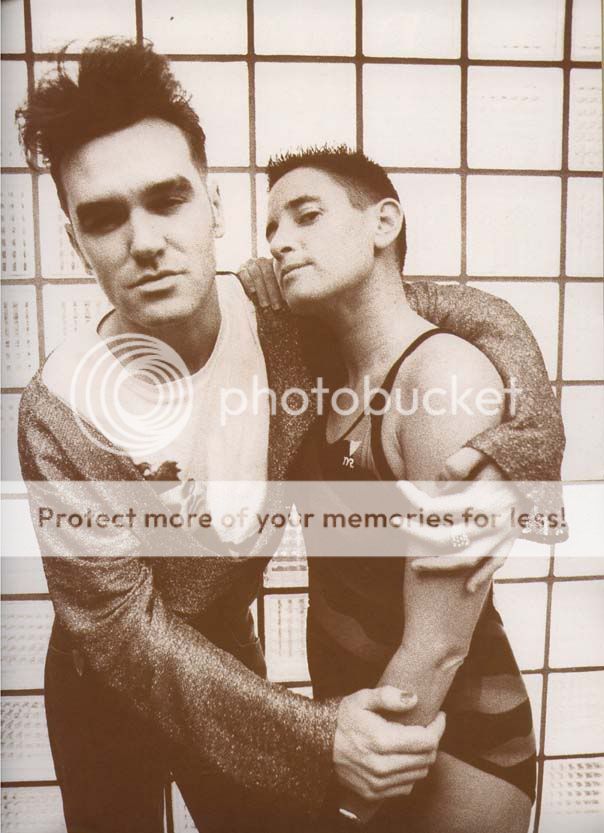goinghome
you must not tamper with arrangements
Phranc’s Butch Closet
The "all-American Jewish lesbian folk singer" shares her life straddling feminist folk and queer punk in a nostalgic show of visual art constructed from cardboard
Written by Trish Bendix | November 29, 2023 - 12:48 pm
“The metaphor of the closet for queers has been hiding—being ‘in the closet,'” says Phranc. “But the closet is also a place to keep things, a place of safety. It’s a place where you get dressed, you get ready to face the world, and so I’m kind of reclaiming the closet and reclaiming the word ‘butch’ too. It’s my identity.”
Phranc poses with a cardboard guitar for her visual art exhibition "The Butch Closet" (Photo courtesy of Phranc and Craig Krull Gallery)
The self-proclaimed “all-American Jewish lesbian folk singer” has been an integral part of both the L.A. punk scene and the feminist-driven women’s music community from their germinal beginnings. Equally inspired by Patti Smith and Joni Mitchell, Alice Bag and Alix Dobkin, Phranc’s personal brand of folk-punk has helped unify what’s often seen as two separate subcultures—a link now made tangible in her autobiographical visual art exhibition, “Phranc: The Butch Closet.”
Born and raised in Los Angeles, Phranc, now 66, has always made visual art. “I made it back in the days of punk rock when I was in Nervous Gender and living on Normal Avenue,” she tells SPIN over Zoom. “I painted a lot of food then because I was hungry, and I had sales to pay the rent the day [it] was due.”
Archival photo of the artist (courtesy of Phranc)

Phranc’s medium is cardboard—it’s free and easy to find—and she’s been constructing things out of boxes since she worked bagging groceries while playing in germinal bands like queercore pioneers Nervous Gender and Catholic Discipline, the latter immortalized in Penelope Spheeris’s 1981 documentary The Decline of Western Civilization. In the film, a young, boyish Phranc appears in a hat, suit, and tie on stage at Madame Wong’s—a Chinatown venue that was home to many L.A. punk performances before things turned macho and disillusioned, with neo-Nazis taking up space in a scene created by weirdos of all stripes, not just white. That shift inspired Phranc’s return to folk music, as she turned down the volume and prioritized lyrics on songs like “Take Off Your Swastika,” an earnest and literal political tune she still performs in its unfortunate timelessness.
At an age when most of her contemporaries have written literary memoirs, Phranc prefers to work with her hands. Now open in her hometown of L.A., “The Butch Closet” is a live version of her life story—a companion piece to her music as released on albums from Rhino Records, Island, Kill Rock Stars, and her own label, Phancy, over a span of 13 years.
Throughout the exhibit, running now through December 2 at the Craig Krull Gallery in Santa Monica, are pieces from Phranc’s adult life: a colorful array of bow and neckties, a painting of Jr. Dyke Brand Butch Boxer shorts, a replica of her ’66 Martin 00-18 guitar. There’s a rack of carefully constructed black and brown belts with names on them—Curly, Rusty, Phranc & Co., Buck, Jack—and TV screens playing 8mm home videos, television appearances, interviews and performances, and other filmic evidence of a “life-lover,” as one of Phranc’s songs professes her to be.
“I feel like the personal intention in the story of creating a visual piece, making something out of cardboard—let’s say my paper combat boots—they’re very much a self-portrait of who I am. It would be just like listening to me sing ‘Amazons’ to see that pair of combat boots,” Phranc says, referencing a song celebrating the physical strength and prowess of athletes like Diana Nyad and Martina Navratilova. “So I feel that my paper sculpture is really a visual illustration of me, and it does really work in tandem with my songs. I think you can listen to the songs and look at the objects—maybe that fills in the space in between.”
Phranc has reconstructed several significant items from her past, from her baby blanket to her Slash magazine T-shirt. Three rooms are divided by paper clothing items hanging on racks in doorways that visitors must physically separate to move through from the past (including a childhood Lamb Chop Halloween costume, a detested red dress spinning in the air, and a coveted robe of her brother’s) to a room full of ephemera, with press clippings, headshots, magazine covers, photographs, and show bills alongside a six-foot-tall poster of Phranc’s chiseled jaw and long lashes from the cover of her 1985 debut, Folksinger.
[Phranc fashion art selection]
“If I had waited around for somebody to make my first album, ‘Folksinger, I don’t know if I would’ve ever really had a career,” Phranc says. Similarly, no one was banging down her door for a retrospective of her visual art—so she did what she’s always done and did it herself, but with the help of friends from the punk and queer communities she grew up in.
“I delivered something that was already made, and that’s what I’ve always done—I’ve done the recording, helped with the art direction, hired the greatest photographers,” Phranc says. “I’ve always worked with the greatest artists to make a package that I love—and then I could sell it.”
The Folksinger poster that hangs in “The Butch Closet” was plastered all over the U.K. to promote a solo club tour, with Stiff Records distributing her debut overseas. Those images, alongside an appearance on The Old Grey Whistle Test, might have been what piqued Morrissey’s interest in her as an opening act for the Smiths’ 1986 world tour. Phranc’s 20-something mug appears on her all-access pass for The Queen is Dead—and in a now-iconic backstage photo of Phranc and Moz topless along with his band while opening for his 1991 solo run.
“I always make a point of going to see the opening act,” says Phranc, who also opened for the Pogues in the U.K. and played shows with the Circle Jerks, Husker Du, and Bikini Kill. “I’ve been that opening act so many times—and then it changes. But It was the artists that brought me on the tour. I didn’t have a great booking agency that got me any gigs.”
By 1991, Phranc was at the height of her career. Appearing in high-femme drag for a Francesco Scavullo-shot cover of PAPER Magazine’s April Fools issue (also featured in “The Butch Closet”), she followed up the success of her 1989 Island Records debut, I Enjoy Being a Girl, with Positively Phranc, and got creative with promotion on stage.
“I would get a box of Tampax, and I would stamp each tampon with ‘I Enjoy Being a Girl.’ When I came out to do the song, I threw them out into the audience,” Phranc says, grinning. “I think they got it.”
...
Audiences were responding. But in 1991, Phranc was tragically stopped short of playing Madison Square Garden with Morrissey when she received a call that her brother had been murdered in San Diego. With no will to perform, despite calls from the former Smiths frontman to come back to the road, Phranc returned to the solitude of visual art. The third room of “The Butch Closet” is a mock-up of Phranc’s studio from 1991 through 2006, located at the 18th Street Arts Center in Santa Monica, where she began recreating significant and nostalgic items from her past.
“I thought, ‘Wow, if I can make them, then all those memories will come back,'” Phranc says.
The recreated workshop shelves include items like a box of Bulldagger Tampons, a faux leather jacket, and pair of matching boots; a bucket of lard and white patent shoes; and her grandmother’s still-operating sewing machine. Some pieces are in progress, while others are complete. On the wall are massive rolls of paper painted the plaid of a childhood jacket that most matched her identity as a burgeoning tomboy, otherwise forced into femininity until she could choose to dress for herself. It’s all a part of her closet.
Phranc eventually returned to performing—first as a Neil Diamond drag king called Hot August Phranc and then with a Kill Rock Stars EP, 1995’s Goofyfoot, that celebrated her renewed love of surfing and nurtured relationships with young queers and riot grrrls like those who appeared as her session musicians: Donna Dresch, Tobi Vail of Bikini Kill, and original Hole drummer Patty Schemel. (Her generational inspiration shows up on Team Dresch’s 1996 album, Captain My Captain, in a tribute called “Uncle Phranc.”)
“It’s my job, since I have survived, to be out,” Phranc says. “I made a commitment to being out, no matter where I was, and that’s why I’m always out on the stage, and that’s why I’ve always been so vocal. Because it was not easy.”
Phranc now splits her time between L.A. and Vancouver but continues to travel with her work. “The Butch Closet” will go to the University of Michigan in part next fall, followed by what she hopes will be showings of the exhibit in full.
She’s also got a new album planned—her first in 25 years—with unrecorded and unreleased material, some of which she’s played live, as she continues to do. A documentary about her foray into selling Tupperware in the ’90s, Lifetime Guarantee: Phranc’s Adventures in Plastic (complete with her own “Tupperware Lady” theme song), has just been made available for the first time, streaming on The Criterion Channel as part of a series called “Masc: 19 films about trans men, butch lesbians and gender-nonconforming heroes.” There’s also a documentary about “The Butch Closet” in progress from Canadian filmmaker Paige Gratland.
Perhaps most exciting: Phranc’s complete discography—from Folksinger through 1998’s self-released Milkman—is finally available for the first time in 30 years.
“All of my work was out of print,” Phranc says. She credits her persistence to track down the masters and help from “digital whizz” Nadine Torres, drummer for The Groans, in helping get her work available to stream. As much as Phranc has done things on her own, she’s quick to name the community members who have helped her get her work out into the world.
“I left home at a very early age, and I found my way, and I was just lucky that it was a community for me to fall into the arms of,” Phranc says. “And so I wanna be part of that community now. And that’s my job—that’s part of who I am.”

Phranc's Butch Closet - SPIN
Phranc, the self-described "all-American Jewish lesbian folk singer," spoke to SPIN about her visual art exhibition "The Butch Closet."
 www.spin.com
www.spin.com
Also, see page 1 of Morrissey support acts compilation, posts 4-8 - https://www.tapatalk.com/groups/nee...821.html?sid=1fa5e597d518a072b1570e42e865cf42



